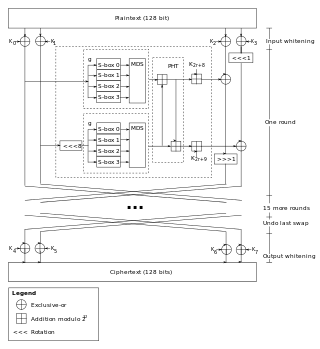Twofish
In cryptography, Twofish is a symmetric key block cipher with a block size of 128 bits and key sizes up to 256 bits. It was one of the five finalists of the Advanced Encryption Standard contest, but it was not selected for standardization. Twofish is related to the earlier block cipher Blowfish.
 The Twofish algorithm | |
| General | |
|---|---|
| Designers | Bruce Schneier |
| First published | 1998 |
| Derived from | Blowfish, SAFER, Square |
| Related to | Threefish |
| Certification | AES finalist |
| Cipher detail | |
| Key sizes | 128, 192 or 256 bits |
| Block sizes | 128 bits |
| Structure | Feistel network |
| Rounds | 16 |
| Best public cryptanalysis | |
| Truncated differential cryptanalysis requiring roughly 251 chosen plaintexts.[1] Impossible differential attack that breaks 6 rounds out of 16 of the 256-bit key version using 2256 steps.[2] | |
Twofish's distinctive features are the use of pre-computed key-dependent S-boxes, and a relatively complex key schedule. One half of an n-bit key is used as the actual encryption key and the other half of the n-bit key is used to modify the encryption algorithm (key-dependent S-boxes). Twofish borrows some elements from other designs; for example, the pseudo-Hadamard transform[3] (PHT) from the SAFER family of ciphers. Twofish has a Feistel structure like DES. Twofish also employs a Maximum Distance Separable matrix.
Back in 2000, on most software platforms Twofish was slightly slower than Rijndael (the chosen algorithm for Advanced Encryption Standard) for 128-bit keys, but somewhat faster for 256-bit keys. But after Rijndael was chosen as the Advanced Encryption Standard, Twofish has become much slower than Rijndael on the CPUs that support the AES instruction set.[4]
Twofish was designed by Bruce Schneier, John Kelsey, Doug Whiting, David Wagner, Chris Hall, and Niels Ferguson: the "extended Twofish team" who met to perform further cryptanalysis of Twofish. Other AES contest entrants included Stefan Lucks, Tadayoshi Kohno, and Mike Stay.
The Twofish cipher has not been patented, and the reference implementation has been placed in the public domain. As a result, the Twofish algorithm is free for anyone to use without any restrictions whatsoever. It is one of a few ciphers included in the OpenPGP standard (RFC 4880). However, Twofish has seen less widespread usage than Blowfish, which has been available longer.
Cryptanalysis
In 1999, Niels Ferguson published an impossible differential attack that breaks six rounds out of 16 of the 256-bit key version using 2256 steps.[2]
As of 2000, the best published cryptanalysis of the Twofish block cipher is a truncated differential cryptanalysis of the full 16-round version. The paper claims that the probability of truncated differentials is 2−57.3 per block and that it will take roughly 251 chosen plaintexts (32 petabytes worth of data) to find a good pair of truncated differentials.[5]
Bruce Schneier responded in a 2005 blog entry that this paper did not present a full cryptanalytic attack, but only some hypothesized differential characteristics: "But even from a theoretical perspective, Twofish isn't even remotely broken. There have been no extensions to these results since they were published in 2000."[6]
References
-
Ship Moriai; Yiqun Lisa Yin (2000). "Cryptanalysis of Twofish (II)" (PDF). Retrieved 2013-01-14. Cite journal requires
|journal=(help) - Niels Ferguson (1999-10-05). "Impossible differentials in Twofish" (PDF). Retrieved 2013-01-14. Cite journal requires
|journal=(help) - "Team Men In Black Presents: TwoFish" (PDF). Archived from the original (PDF) on 26 September 2017.
- Bruce Schneier; Doug Whiting (2000-04-07). "A Performance Comparison of the Five AES Finalists" (PDF/PostScript). Retrieved 2013-01-14. Cite journal requires
|journal=(help) -
Shiho Moriai; Yiqun Lisa Yin (2000). "Cryptanalysis of Twofish (II)" (PDF). Retrieved 2013-01-14. Cite journal requires
|journal=(help) - Schneier, Bruce (2005-11-23). "Twofish Cryptanalysis Rumors". Schneier on Security blog. Retrieved 2013-01-14.
Articles
- Bruce Schneier; John Kelsey; Doug Whiting; David Wagner; Chris Hall; Niels Ferguson (1998-06-15). "The Twofish Encryption Algorithm" (PDF/PostScript). Retrieved 2013-01-14. Cite journal requires
|journal=(help) - Bruce Schneier; John Kelsey; Doug Whiting; David Wagner; Chris Hall; Niels Ferguson (1999-03-22). The Twofish Encryption Algorithm: A 128-Bit Block Cipher. New York City: John Wiley & Sons. ISBN 0-471-35381-7.
External links
- Twofish web page, with full specifications, free source code, and other Twofish resources by Bruce Schneier
- 256 bit ciphers – TWOFISH reference implementation and derived code
- Products that Use Twofish by Bruce Schneier
- Better algorithm: Rijndael or TwoFish? by sci.crypt
- Standard Cryptographic Algorithm Naming: Twofish